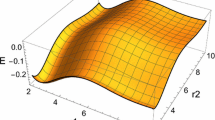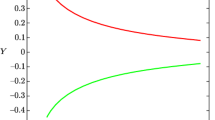Abstract
Valley-ridge inflection points (VRIs) emerge on a potential energy surface of a chemical reaction if the reaction pathway bifurcates. The valley of the reaction path branches into two valleys, and a ridge in between. It can happen in uphill or in downhill direction. Newton trajectories (NT) are curves for the description of the reaction path. They are curves where at every point the gradient of the potential energy surface points into the same direction. Singular Newton trajectories are a special case: they bifurcate at VRI points. To find a singular Newton trajectory is quasi equivalent with the determination of the corresponding VRI point where this NT bifurcates. Often the bifurcation of the reaction path is governed by a symmetry of the problem. Then the symmetry axis is usually the first branch of the singular NT, and so its determination is easy. In case of an unsymmetric branching, however, such a guiding line is missing. We name the place of such a bifurcation a skew VRI. We propose a variational calculation of the singular NT through the VRI of interest by an empirical, iterative method. Before, the variational theory of possible reaction pathways is developed and applied to the intrinsic reaction coordinate (IRC), as well as to NTs. We have to employ the theory of NTs with its many facets, we use especially the Branin equation. The developed method is applied to the calculation of VRI points on the potential energy surface of HCN and to a VRI point of alanine dipeptide being adjacent to the C5 minimum.








Similar content being viewed by others
References
Quapp W, Hirsch M, Imig O, Heidrich D (1998) J Comput Chem 19:1087
Quapp W, Hirsch M, Heidrich D (1998) Theor Chem Acc 100:285
Anglada JM, Besalu E, Bofill JM, Crehuet R (2001) J Comput Chem 22:387
Bofill JM, Anglada JM (2001) Theor Chem Acc 105:463
Crehuet R, Bofill JM, Anglada JM (2002) Theor Chem Acc 107:130
Hirsch H, Quapp W, Heidrich D (1999) Phys Chem Chem Phys 1:5291
Quapp W (2009) J Theor Comput Chem 8:101
Heidrich D (1995) The reaction path in chemistry, current approaches and perspectives. Kluwer, Dordrecht
Heidrich D, Kliesch W, Quapp W (1991) Properties of chemically interesting potential energy surfaces, lecture notes chem 56. Springer, Berlin
Laidler K (1969) Theory of reaction rates. McGraw-Hill, New York
Quapp W, Zech A (2010) J Comput Chem 31:573
Truhlar DG, Garrett BC (1980) Acc Chem Res 13:440
Hirsch M, Quapp W (2004) J Mol Struct(Theochem) 683:1
Bakken V, Danovich D, Shaik S, Schlegel HB (2001) J Am Chem Soc 123:130
Quadrelli P, Romano S, Toma L, Caramella P (2002) Tetrahedron Lett 43:8785
Ussing BR, Hang C, Singleton DA (2006) J Am Chem Soc 128:7594
Thomas JB, Waas JR, Harmata M, Singleton DA (2008) J Am Chem Soc 130:14544
Ess DH, Weeler SE, Iafe RG, Xu L, Çelebi-Ölçüm N, Houk KN (2008) Angew Chem Int Ed 47:7592
Tantillo DJ (2008) J Phys Org Chem 21:561
Hong YJ, Tantillo DJ (2009) Nature Chem 1:384
Yamataka H, Sato M, Hasegawa H, Ammal SC (2010) Faraday Discuss 145:327
Quapp W (2008) Theor Chem Acc 121:227
Bofill JM (2009) J Chem Phys 130:176102
Elber R, Karplus M (1987) Chem Phys Lett 139:375
Czerminski R, Elber R (1990) Int J Quant Chem S 24:167
Elber R (1996) In: Elber R (ed) Recent developments in theoretical studies of proteins. World Scientific, Singapore, p 65
Pratt LR (1986) J Chem Phys 85:5045
Crehuet R, Bofill JM (2005) J Chem Phys 122:234105
Aguilar-Mogas A, Crehuet R, Giménez X, Bofill JM (2007) Mol Phys 105:2475
Aguilar-Mogas A, Crehuet R, Bofill JM (2008) J Chem Phys 128:104102
Vanden-Eijnden E, Heymann M (2008) J Chem Phys 128:061103
Heymann M, Vanden-Eijnden E (2008) Comm Pure Appl Math 61:1052
Gelfand IM, Fomin SV (1991) Calculus of variations. Dover Publ Inc, Mineola, New York
Fukui K (1974) J Phys Chem 74:4161
Fukui K (1974) In: Daudel R, Pullman P (eds) The world of quantum chemistry. Dordrecht, Reidel, p 113
Fukui K (1970) J Phys Chem 74:4161
Tachibana A, Fukui K (1978) Theor Chim Acta 49:321
Quapp W, Heidrich D (1984) Theor Chim Acta 66:245
Garrett BC, Redmon MJ, Steckler R, Truhlar DG, Baldridge KK, Bartol D, Schmidt MW, Gordon MS (1988) J Phys Chem 92:1476
Schlegel HB (1994) J Chem Soc, Faraday Trans 90:1569
Quapp W (1994) J Chem Soc, Faraday Trans 90:1607
Basilevsky MV, Shamov AG (1981) Chem Phys 60:337; and 60:347
Hoffman DK, Nord RS, Ruedenberg K (1986) Theor Chim Acta 69:265
Quapp W (1989) Theoret Chim Acta 75:447
Sun J-Q, Ruedenberg K (1993) J Chem Phys 98:9707
Quapp W, Imig O, Heidrich D (1995) In: Heidrich D (ed) The reaction path in chemistry, current approaches and perspectives. Kluwer, Dordrecht, p137
Jensen F (1995) J Chem Phys 102:6706
Quapp W, Hirsch M, Heidrich D (2000) Theor Chem Acc 105:145
Quapp W, Bofill JM (2010) J Computat Chem submitted
Hirsch M, Quapp W (2004) J Math Chem 36:307
Moser J (2003) Selected chapters in the calculus of variations. Birkhäuser, Lect Math, ETH Zürich
Truhlar DG, Kupperman AJ (1971) J Am Chem Soc 93:1840
Olender R, Elber R (1997) J Mol Struc(Theochem) 398-399:63
Stacho LL, Dömötör G, Ban MI (2000) J Math Chem 28:241
Carathéodory C (1935) Variationsrechnung und partielle Differentialgleichungen erster Ordnung. Teubner, Leipzig
Quapp W (2003) J Theor Comp Chem 2:385
Czerminski R, Elber R (1990) J Chem Phys 92:5580
Steckler R, Truhlar DG (1990) J Chem Phys 93:6570
Williams IH, Maggiora GM (1982) J Mol Struct(Theochem) 89:365
Ulitzky A, Elber R (1990) J Chem Phys 92:1510
Branin FH (1972) IBM J Res Develop :504
Jongen HT, Jonker P, Twilt F (1987) In: Guddat J et al. (eds) Parametric optimization and related topics. Akademie-Verlag, Berlin, pp 209–300
Jongen HT (1990) In: Allgower EL, Georg K (eds) Computational solutions of nonlinear systems of equations. Amer Math Soc, Providence, p 317
Diener I, Schaback R (1990) J Optimiz Theory Appl 67:87
Diener I (1991) Globale Aspekte des kontinuierlichen Newton-Verfahrens. Habilitation, Göttingen
Gomulka J (1974) In: Towards global optimisation. Dixon LCW, Szegö GP (eds), North-Holland, p 96
Quapp W, Hirsch M, Heidrich D (2004) Theor Chim Acta 112:40
Mezey PG (1987) Potential energy hypersurfaces. Elsevier, Amsterdam
Ruedenberg K, Sun J-Q (1994) J Chem Phys 100:5836
Heidrich D, Quapp W (1986) Theor Chim Acta 70:89
Minyaev RM, Getmanskii IV, Quapp W (2004) Russ J Phys Chem 78:1494
Kim H-W, Zeroka D (2008) Int J Quant Chem 108:974
Ezra GS, Wiggins S (2009) J Phys A 42:205101
Haller G, Uzer T, Palacian J, Yanguas P, Jaffe C (2010) Commun Nonlinear Sci Numer Simulat 15:48
Allgower EL, Georg K (1990) Numerical continuation methods. Springer, Berlin
Hirsch M, Quapp W (2002) J Comput Chem 23:887
Schmidt B (2009) Bestimmung von Tal-Rücken-Umschlagpunkten auf Potentialenergieflächen mittels eines Variationsansatzes für Newtontrajektorien. Diplomarbeit, Mathematisches Institut, Universität Leipzig
Quapp W (2005) J Chem Phys 122:1
Quapp W (2004) J Math Chem 36:365
Quapp W (1995) In: Heidrich D (ed) The reaction path in chemistry, current approaches and perspectives. Kluwer, Dordrecht. p 95
Wales DJ (2000) J Chem Phys 113:3926
Quapp W (2001) J Chem Phys 114:609
Quapp W (2010) http://www.math.uni-leipzig.de/~quapp/SkewVRIs/
Schmidt MW, Baldridge KK, Boatz JA, Elbert ST, Gordon MS, Jensen JH, Koseki S, Matsunaga N, Nguyen KA, Su SJ, Windus TL, Dupuis M, Montgomery JA (1993) J Comput Chem 14:1347
Granovsky AA (2009) PC GAMESS, http://www.classic.chem.msu.su/gran/gamess
Chass GA, Sahai M, Law JMS, Lovas S, Farkas Ö, Perczel A, Rivail L-L, Csizmadia IG (2002) Int J Quant Chem 90:933
Vetterling WT, Teukolsky SA, Press WH, Flannery BP (1992) Numerical recipes in Fortran, the art of scientific computing, 2d edition. New York, Cambridge University Press
Sheppard AN, Acevedo O (2009) J Am Chem Soc 131:2530
Acknowledgments
We thank the referees for suggestions and comments.
Author information
Authors and Affiliations
Corresponding author
Rights and permissions
About this article
Cite this article
Quapp, W., Schmidt, B. An empirical, variational method of approach to unsymmetric valley-ridge inflection points. Theor Chem Acc 128, 47–61 (2011). https://doi.org/10.1007/s00214-010-0749-z
Received:
Accepted:
Published:
Issue Date:
DOI: https://doi.org/10.1007/s00214-010-0749-z




